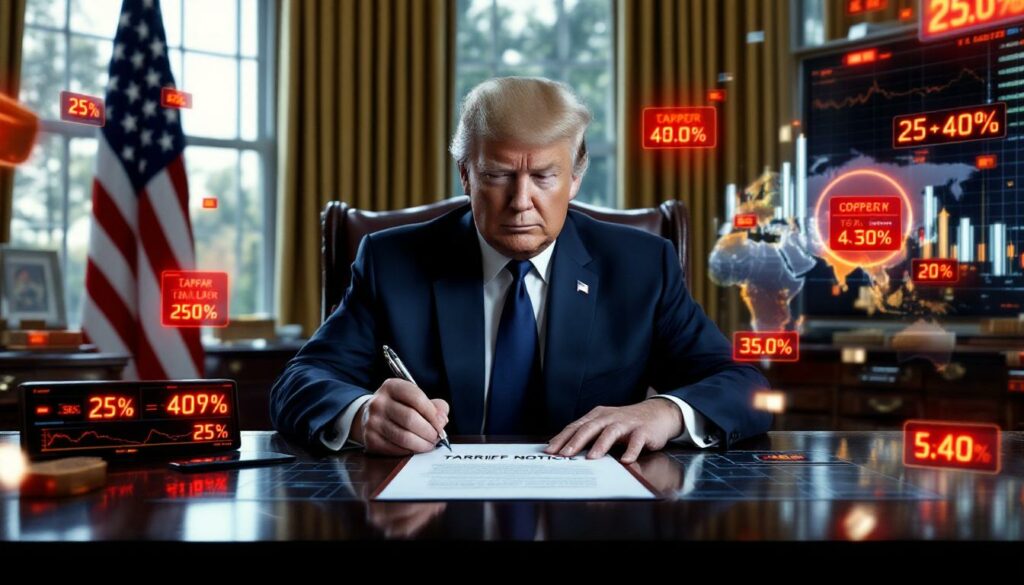US Tariff Notices Create Ripple Effects in Global Copper Markets
The recent wave of non-reciprocal tariff notices issued by the Trump administration has sent significant ripples through global copper markets, creating volatility and uncertainty across trading hubs. With copper being a crucial industrial metal and economic indicator, these trade policy shifts have immediate implications for prices, inventories, and market sentiment. Let's examine the current landscape and what it means for stakeholders across the copper value chain.
What Are the Latest US Tariff Developments?
Trump Administration's New Tariff Strategy
The Trump administration has significantly shifted US trade policy by issuing non-reciprocal tariff notices to 14 countries worldwide. This strategic move introduces a complex tiered tariff structure, including benchmark tariffs of 25% on imports from Japan and South Korea, higher rates of 25-40% for Malaysia and Indonesia, and an additional 10% tariff specifically targeting BRICS nations perceived as maintaining policies contrary to US interests.
In a notable development that has given markets additional breathing room, the White House has extended the tariff negotiation deadline from the original July 9 date to August 1, 2025. This three-week extension provides critical time for trade discussions and potential resolutions before implementation.
"This extension creates a vital window for diplomatic engagement and potential compromise solutions," noted industry analysts tracking the negotiations. "The market is watching closely for signals of flexibility from both sides."
Timeline and Implementation Schedule
The implementation timeline has undergone strategic adjustment, with President Trump signing an executive order to postpone the 90-day suspension period for "reciprocal tariffs" until August 1. This deliberate extension establishes a critical negotiation window between the US administration and affected trading partners, potentially allowing for diplomatic solutions before tariffs impact on supply chains.
Beyond the initial 14 countries receiving notices, the White House has indicated that 12 additional countries will receive trade-related communications in the coming weeks, with further notices to follow. This phased approach suggests a carefully calibrated strategy designed to maximize negotiating leverage while minimizing immediate economic disruption.
How Are Copper Prices Responding to Tariff News?
Current Price Movements and Trading Patterns
Copper markets have displayed notable volatility in direct response to the tariff announcements. On July 7, LME copper opened at $9,807/mt and initially climbed before settling at $9,784/mt—representing a 0.69% decline for the session. Trading volume reached 11,000 lots with open interest holding steady at 281,000 lots.
Similarly, the most-traded SHFE copper 2508 contract opened at 79,370 yuan/mt, initially dipping before recovering to close at 79,390 yuan/mt, down 0.15% for the day. Trading volume hit 17,000 lots, reflecting active but cautious market participation as traders assessed the implications of Trump tariff effects on copper.
These immediate price reactions demonstrate how quickly copper markets absorb and respond to significant policy shifts, particularly those affecting global trade flows of this essential industrial metal.
Market Sentiment and Risk Assessment
The policy uncertainty stemming from the tariff notices has heightened market risk aversion, creating notable downward pressure on copper prices. This sentiment shift comes at a particularly sensitive time, as traders were already recalibrating positions in response to seasonal demand patterns.
The combination of macroeconomic policy disturbances and changing fundamental supply-demand dynamics has created what analysts term a "resonance effect"—where multiple factors amplify each other's impact on market psychology. This effect is particularly evident in the cautious positioning of institutional investors and reduced appetite for long-term copper contracts.
What's Happening in Regional Copper Spot Markets?
Shanghai Market Conditions
Shanghai's copper spot market has experienced measurable softening, with spot premiums for SMM #1 copper cathode against the front-month 2507 contract ranging from 50-140 yuan/mt on July 7. The average premium stood at 95 yuan/mt—a notable decrease of 20 yuan/mt month-over-month.
Market analysts project further downside potential for these spot premiums, citing two primary factors:
- Widening price spreads between futures contracts
- Increasing pressure from imported supplies
These combined elements suggest a continued softening of the premium structure in Shanghai's spot market through the near term, with particularly close attention being paid to import volumes in coming weeks.
Guangdong Market Dynamics
The Guangdong market has experienced more pronounced weakness compared to Shanghai, with #1 copper cathode spot premiums against the front-month contract ranging from a discount of 60 yuan/mt to a premium of 50 yuan/mt. The average stood at a discount of 5 yuan/mt—down 30 yuan/mt month-over-month.
This regional variation reveals important distinctions in local supply-demand balances. Despite overall copper price declines, premium reductions have continued unabated in Guangdong, primarily attributed to downstream consumers' strong reluctance to rebuild inventories given the uncertain price outlook and tariff situation.
The more severe premium erosion in Guangdong compared to Shanghai reflects the region's higher concentration of export-oriented manufacturers who face greater exposure to potential trade disruptions.
Imported Copper Market Assessment
The imported copper segment provides additional insights into market dynamics, with warrant prices standing at $20-38/mt (QP July) on July 7, averaging $1/mt lower month-over-month. B/L prices were quoted at $46-80/mt (QP August), averaging $11/mt higher month-over-month, while EQ copper (CIF B/L) was priced at $0-20/mt (QP July), averaging $12/mt higher month-over-month.
These quotations, referencing mid-to-late July arrival cargoes, indicate a complex market with mixed signals. Overall transaction volume remained relatively flat week-over-week, though trading activity among intermediaries showed some increase as they positioned themselves to capitalize on potential market dislocations resulting from tariff implementation.
Why Are Copper Inventories Rising?
Current Inventory Levels and Trends
As of July 7, 2025, nationwide copper inventories across major regions in China increased by 11,100 mt month-over-month, reaching a total of 142,900 mt. This inventory buildup has been observed consistently across all monitored regions, suggesting a broad-based trend rather than localized effects.
On the international front, LME copper cathode inventory rose by 2,125 mt to reach 97,400 mt, while SHFE warrant inventory decreased by 625 mt to 21,682 mt on the same day. This divergence between exchange inventories highlights the complex interplay of regional market dynamics and trading strategies.
The inventory increases come at a time when seasonal patterns typically predict some accumulation, but the magnitude of the current buildup exceeds normal seasonal variations, pointing to more fundamental shifts in market dynamics.
Supply-Demand Imbalance Factors
The inventory increases can be attributed to two primary factors working in tandem:
- Rising imported copper volumes – Import flows have remained robust despite price volatility
- Weakening end-use consumption – Downstream demand has softened notably, particularly in construction and consumer electronics sectors
The combination of these elements has created significant upward pressure on inventory levels, contributing to the bearish sentiment in copper markets. This fundamental shift in supply-demand dynamics, occurring during the traditional consumption off-season, has amplified the downward pressure on copper prices and spot premiums.
Market participants note that the inventory build is particularly concerning given that August typically sees even weaker seasonal demand, suggesting further inventory accumulation may occur before any significant drawdown begins.
How Is the Secondary Copper Market Performing?
Price Movements in Secondary Copper
The secondary copper market has experienced notable price adjustments in tandem with primary copper movements. Raw material prices have declined by 500 yuan/mt month-over-month as of July 7, reflecting broader market pressures.
Specifically, Guangdong bare bright copper was priced at 73,500-73,700 yuan/mt, down 500 yuan/mt from the previous trading day. The price differential between copper cathode and copper scrap stood at 1,507 yuan/mt, narrowing by 198 yuan/mt month-over-month, while the price gap between copper cathode rod and secondary copper rod was 1,060 yuan/mt.
This compression of the spread between primary and secondary copper products indicates changing economics within the recycling value chain and has important implications for scrap collection rates and processing margins.
Production Strategy Adjustments
According to comprehensive industry surveys, many secondary copper rod enterprises have nearly achieved their production value targets for the first half of 2025. This milestone achievement has significant implications for their near-term operational strategies.
Consequently, these manufacturers are expected to adopt more conservative raw material procurement approaches in the coming months and may appropriately reduce operating days. Some facilities have already announced plans to conduct extended maintenance during the traditional summer slowdown period, effectively reducing market supply without formally announcing production cuts.
This strategic shift could have meaningful impacts on secondary copper market dynamics and potentially influence broader copper price prediction insights and trends, especially if primary copper supplies remain abundant while secondary production decreases.
What Other Market Factors Are Influencing Copper Prices?
Regulatory Developments in Financial Markets
Beyond tariff issues, regulatory developments in adjacent markets are also influencing copper trading patterns. Hong Kong's "Stablecoin Ordinance" is set to take effect in August 2025, with the Hong Kong Monetary Authority currently consulting the market on implementation guidelines.
These guidelines, expected to be published in July, will cover anti-money laundering requirements and related regulations. Only single-digit stablecoin licenses will be issued, with applications anticipated after the ordinance takes effect and license issuance targeted within 2025.
The connection between cryptocurrency regulations and copper markets stems from institutional investors who participate in both spaces, as well as the growing use of blockchain technologies in metals trading and supply chain management. Regulatory clarity may ultimately reduce friction in cross-border metals transactions that increasingly utilize digital payment systems.
Seasonal Consumption Patterns
The traditional consumption off-season is amplifying the impact of rising inventories and trade policy uncertainties. Seasonal demand fluctuations typically result in reduced copper consumption during summer months in the Northern Hemisphere, when construction activity and manufacturing output often experience planned reductions.
The current market environment aligns with these established seasonal patterns but is intensified by the coincidental timing of the tariff announcements. The combination of seasonal factors with macroeconomic policy disturbances has created a particularly challenging environment for copper prices in the short term.
Market veterans note that August typically represents the nadir of seasonal demand before September brings a gradual recovery in consumption patterns, suggesting that near-term price pressure may persist before potential relief emerges later in Q3.
What's the Short-term Outlook for Copper Markets?
Price Pressure Factors
The short-term outlook for copper markets suggests continued price pressure due to multiple converging factors:
- Uncertainty surrounding US issues non-reciprocal tariff notices and copper prices under short-term pressure
- Rising inventories across major trading hubs signaling potential oversupply conditions
- Weakening consumption in key end-use sectors, particularly construction and consumer electronics
- Seasonal demand patterns amplifying fundamental weaknesses
These elements, working in combination, suggest that copper investment strategies may need to account for continued downward pressure in the near term, with potential stabilization dependent on either significant supply adjustments or clarity on the tariff situation.
"The market is confronting a perfect storm of negative factors," notes a veteran metals trader. "Seasonal weakness combined with policy uncertainty creates a challenging environment for bullish positioning."
Market Monitoring Indicators
Key indicators that market participants should monitor include:
- Developments in US-China trade relations, especially any signals of compromise or hardening positions
- Changes in global copper inventory levels, particularly drawdowns that might indicate demand recovery
- Shifts in manufacturing activity across major economies, especially PMI readings for copper-intensive sectors
- Adjustments to the August 1 tariff implementation deadline, which could significantly impact market sentiment
Additionally, any notable production curtailment announcements from major miners or smelters could provide a counterbalance to the current bearish factors, potentially supporting prices even amid demand concerns.
Traders and analysts will be closely watching these factors to gauge potential price movements in the coming weeks, with particular attention to how negotiating positions evolve ahead of the August 1 deadline.
Understanding the Copper Market Impact: Key Questions Answered
How might the new US tariffs affect global copper supply chains?
The proposed US tariffs could significantly disrupt established copper supply chains by altering trade flows and potentially creating regional price disparities. Countries facing higher tariff rates may redirect exports to alternative markets, potentially creating:
- Oversupply conditions in non-US markets
- Price premiums for tariff-exempt material delivered to US consumers
- Logistics bottlenecks as shipping patterns adjust
Manufacturing industries reliant on copper imports might face higher input costs, potentially leading to production adjustments or price increases for end products. This could particularly impact sectors like electronics, automotive, and construction that require significant copper inputs.
What are the implications for copper-producing countries?
Major copper-producing nations will experience varying impacts depending on their export exposure to the US market and their inclusion in the tariff structure:
- Chile and Peru: As leading global producers, their response to changing trade patterns will significantly influence global copper supply forecast
- Countries targeted with higher tariffs: May face reduced export competitiveness, potentially leading to production cutbacks
- Producers exempt from or less affected by tariffs: Could gain market share in US imports, creating competitive advantages
This reshuffling of market positions could have lasting implications for investment in new copper production capacity, potentially influencing the global supply landscape for years beyond the immediate tariff situation.
How do seasonal factors typically affect copper prices?
Copper markets traditionally experience predictable seasonal demand fluctuations:
- Summer slowdown (June-August): Consumption often declines when construction and manufacturing activities slow down in the Northern Hemisphere
- Autumn recovery (September-November): Demand typically strengthens as manufacturers rebuild inventories
- Pre-holiday buildup (December): Activity often increases before year-end shutdowns
- Post-holiday resumption (January-February): Gradual recovery as operations resume after winter holidays
This seasonal pattern typically creates inventory buildups and price pressure during summer months, followed by potential recovery as demand strengthens in autumn. The current market situation aligns with these seasonal expectations but is amplified by additional macroeconomic uncertainties.
What strategies are traders adopting in response to current market conditions?
Market participants are implementing various strategies to navigate the current environment:
- Reduced speculative positions: Limiting exposure to potential price volatility
- Increased hedging activities: Securing prices for future production or consumption needs
- Conservative inventory management: Minimizing holdings to reduce carrying costs and price risk
- Regional arbitrage: Exploiting price differentials between markets affected differently by tariff prospects
Traders are closely monitoring policy developments and fundamental indicators while maintaining flexibility to respond to rapidly changing market conditions. Some are also exploring arbitrage opportunities arising from regional price differentials and contract spread variations, capitalizing on market inefficiencies created by the uncertain policy environment.
Further Exploration
Readers interested in learning more about global metals markets and trade policy impacts should monitor developments in the following areas:
- Official communications from the US Trade Representative regarding tariff implementation details
- Production response announcements from major copper miners and refiners
- Changes in trade flow patterns as reported by customs authorities in key importing nations
- Inventory movements across major exchanges (LME, SHFE, COMEX) as leading indicators of market imbalances
The interconnected nature of global copper markets means that even localized policy changes can have far-reaching implications across the value chain, making comprehensive monitoring essential for all market participants navigating this period of heightened uncertainty.
Ready to Stay Ahead of the Next Major Market Shift?
Gain immediate insights into significant market movements with real-time alerts from Discovery Alert's proprietary Discovery IQ model, helping you navigate volatile copper markets and other commodities with confidence. Explore our dedicated discoveries page to understand how major market shifts can lead to exceptional investment outcomes.




